My Italian-born guide Angela is twisting her Fiat Cinquecento around the corkscrew turns of the achingly scenic Lavaux. We’re in Switzerland’s UNESCO-listed wine country, a stretch of honey-stoned, chocolate box villages set amongst grape terraces built by monks in the 12th-century. It’s just one segment of the so-called Swiss Riviera that stretches for 30-kilometres from Lausanne to Montreux along the southern shore of Lake Geneva (Lac Léman). The whole of it swoops down a steep hillside towards the lake, which gives this white wine growing region its Med-like microclimate.
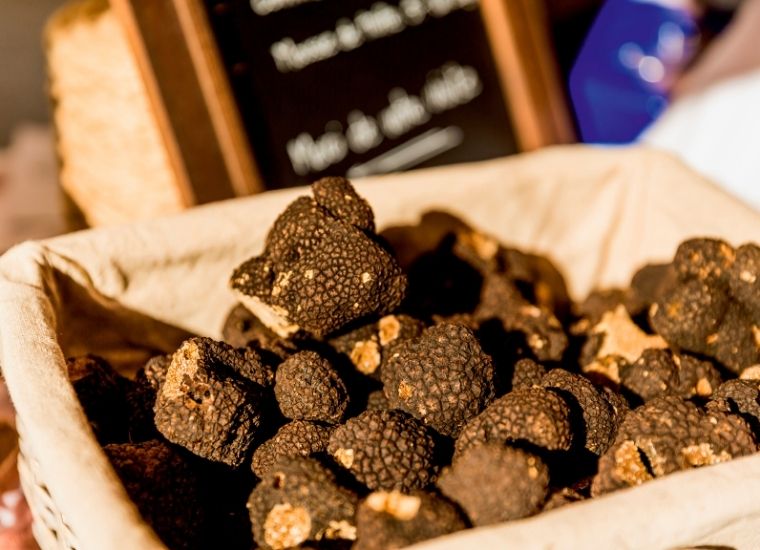
I met Angela just moments ago in my Montreux hotel lobby, where she picks me up for our day in the vineyards. The first thing she says to me in her Napoli accent: “You live in the Swiss-German part of Switzerland? I’m so sorry.”
It isn’t the first time I’d heard disdain for German-speaking Switzerland. It’s a sentiment you frequently hear in the Italian and French-speaking parts of Switzerland, especially in regards to Swiss German cuisine. And I understand why. The food of Romandie is marked by butter-based sauces, elaborate pastry, and cuisine that pays homage to France’s ancien regime as well as Savoyard, Burgundian, Alsatian, Napoleonic, and Gaulish heritage.
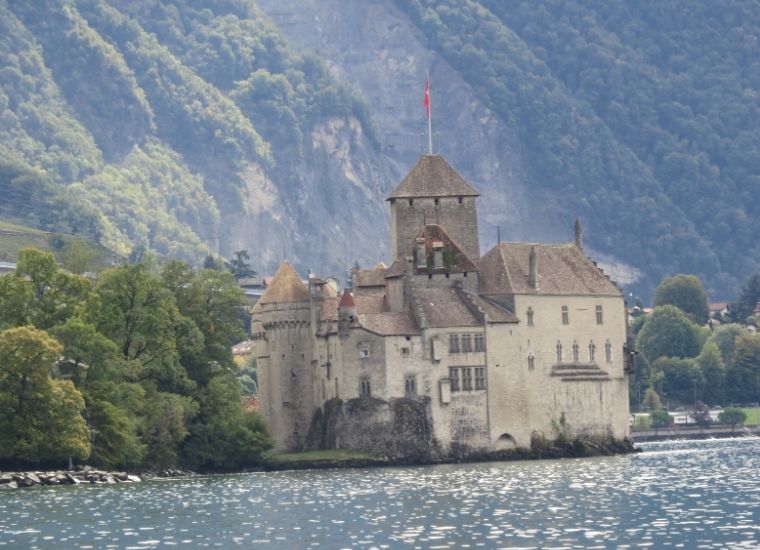
Angela parked the car in the picturesque village of Grandvaux surrounded by vineyards sliced with train tracks and backdropped with arresting views of the lake and the snow-dusted French alps. We were about to do what inhabitants of the Lavaux do best: eat lunch.
We settled into our table at the Auberge de la Gare, where men in suits next to us removed their ties, tucked napkins into their perfectly pressed oxfords, and ordered a bottle of wine on a Tuesday afternoon. From the kitchen, wafts of garlic, fish, and smoked duck filled the air while we continued to discuss the food of the Romandie.
“The food here is French. But we’re only 90 minutes from Italy, so don’t underestimate the Italian influences,” says Angela enthusiastically. “And we all know the Italians taught the French how to cook,” she says smiling, gesturing with her two open hands as my fish soup and saffron mayonnaise arrived. “But the Germans,” she says wagging her finger. “We didn’t teach them.”
- STARTERS AND MAINS
- CAVE AND WINE
- MARCHÉ
- CHEESE AND DESSERT
STARTERS AND MAINS
There are no shortages of cosy wine taverns and auberges with crackling fireplaces in the Swiss Riviera. But one place is iconic just outside Lausanne: Crissier’s Restaurant de l’Hôtel de Ville, one of only three three-starred Michelin restaurants in the country.
Dishes like caramelized scallops with local reduction of chasselas wine, hare à la royale, and alpine chamois with a wild green pepper sauce were not things you’d ever see on my side of the röstigraben. Chef Franck Giovannini’s 11-course tasting menu is a treasure trove of nostalgia and flavor, riffing on French haute with heavy punches of alpine resourcefulness.
If that weren’t opulent enough, just a few kilometres away is another temple to haute cuisine: the two Michelin-star Anne-Sophie Pic. It is located inside Lausanne’s iconic Beau-Rivage Palace, a Belle Epoque masterpiece of hospitality with white marble and Corinthian columned ballrooms overlooking the city’s leafy Olympic Park shoreline. The menu takes inspiration from local produce with flowery spinoffs like a soft boiled egg with baby cabbage, roast geranium, and sudachi foam, or blue lobster with nasturtium coulis and cinnamon consommé. Serve that in austere Zürich, Spartan Lucerne, or even French-bordering Basel and inevitably someone would complain that it was too bold, not disciplined enough, or trying too hard.
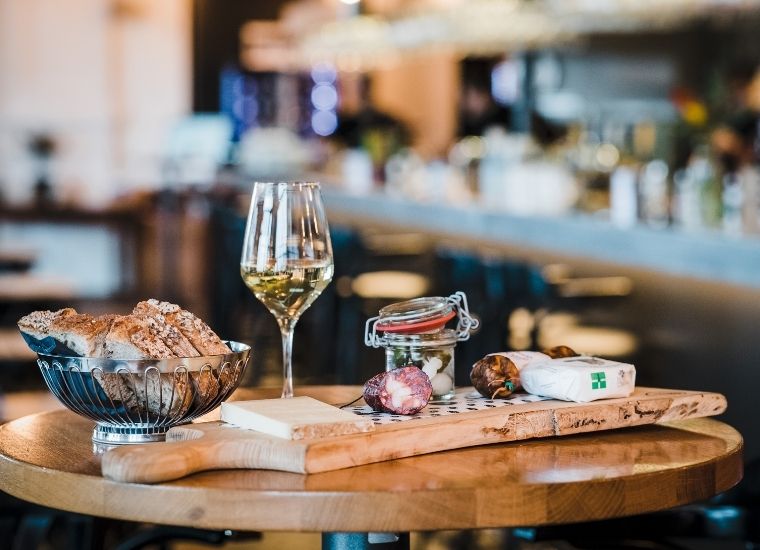
Brasserie de Montbenon, located in a carved-out hall inside Lausanne’s casino, is bustling and chock full of the city’s jeunesse dorée (young and wealthy) dining on vol au vents stuffed with creamy sauces, mushroom cassoulets, and beef tartars washed down with bottles of wine. Montreux’s La Rouvenaz offers French brasserie classics with a handful of Italian trattoria dishes— raw oysters, steak de bœuf, veal stews, and homemade pasta are edifying and unapologetically caloric and carby. Auberge du Raisin in the charming Lavaux town of Cully is a longtime personal favourite and delivers doses of old world dining that is rapidly disappearing. The floors are stone and worn. The wood panelling and parquet ceiling is marinated in decades of fondue steam. And fussy suited waiters char aged steaks on the dining room’s fireplace, prepare flambés table-side by, and drench morels and white asparagus in Mornay sauce from silver gravy boats sur la table.
This is the eating I’d expected from Europeans. The culture of living for food is what Angela feels is misunderstood by the Swiss Germans.
- STARTERS AND MAINS
- CAVE AND WINE
- MARCHÉ
- CHEESE AND DESSERT
CAVE AND WINE
No visit to French-speaking Switzerland is complete with a visit to one of its wineries. Switzerland is also home to over 20 wine appellations, found in almost every canton, including urban wine appellations in Geneva, Zurich, Basel, Bern, and Lucerne, and high altitude wines that stretch to the heavens like Machu Picchu in Canton Valais.
There are over 200 grape varieties grown in Switzerland, but the nomenclature of grape names vary from region to region. What’s called Chasselas in Canton Vaud is called Fendant in Canton Valais. What’s more confusing is that unlike its neighbours in Germany, Austrian France, and Italy, Switzerland doesn’t have a centralized wine body, so grape expressions and growing methods are different, too. The country notoriously only exports 1% of its production, and you have quite a rarefied product. Luckily for the hardworking winemakers, Swiss wines have been gaining popularity after renown oenophiles and critics from Wine Advocate and the Financial Times lauded them repeatedly in the last decade. And celebrity chefs and sommeliers have been stocking them in the cellars more and more.
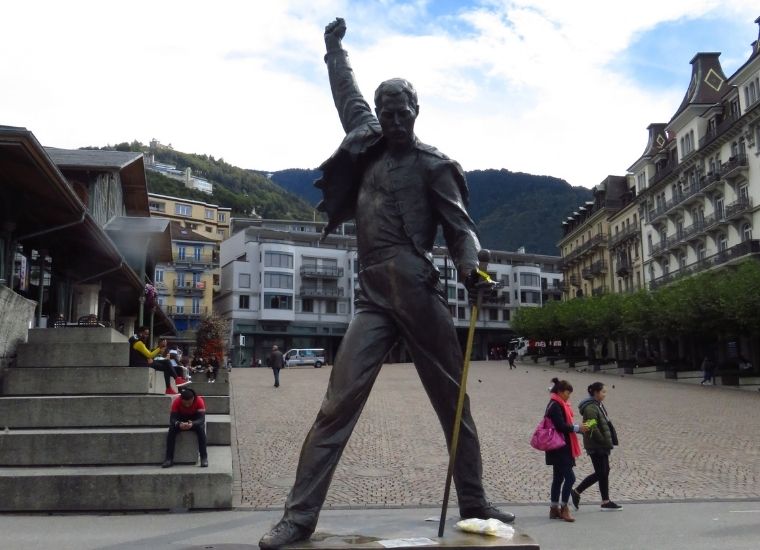
By far, the most famous wine in all of Switzerland is Chasselas, known for its stony, gunpowder characteristics, which French-speaking Swiss call pierre à fusil, an old aristocratic term which translates to musket flint. While many Swiss people would not agree about the grape’s nomenclature, almost all Swiss agree that the Chasselas is the only wine that should be consumed with fondue, a rule seldom broken. I tried to bend this rule after moving here, but failed time and again. But let my mistake be your lesson. The only thing worse than asking for red wine with your fondue is asking for soda which is borderline criminal. Regardless of which side of the röstigraben you’re on, locals will tell you that a cold beverage will harden the melted cheese in your stomach, a frequently heard line with zero science to back it up. Some things do cross over. And since chasselas is generally so refreshing and nicely paired with cheese, it’s seldom worth arguing over.
The Swiss also produce excellent blauburgunder (Pinot Noir) in Cantons Graubunden and Schaffhausen, and fine white and red Merlot in Italian speaking Ticino. You can find those in the Romandie too. Still, visiting oenophiles will want to focus on and seek out lesser known dry mineral varietals like Amigne, Dôle Blanche, Petite Arvine, Heida, and Sylvaner, (or Païen and Johannisberg if you’re speaking upper Valesian dialect). Reds like Humagne Rouge, Dôle Carminoir, Durize, Eyholzer Roter Ermitage, Doral, Gamey, and even ancient Lémanic reds like the Plant Robert varietal are unusual and worth bagging a bottle or two.
On previous visits to the Lavaux, I rented an e-bike to get around, which is an excellent way to experience the quiet charm of the landscape and get a bit of a battery boost to help climbs the steep hills. The Lavaux alone includes the appellations of Lutry, Villette, Épesses, Calamin grand cru, Dézaley grand cru (vignoble de la commune de Puidoux), Saint-Saphorin, Chardonne, and Vevey-Montreux, so there’s plenty to see. A few favorite wineries include Blaise Duboux in Epesses and Pierre-Luc Leyvraz in the equally bucolic hamlet of St-Saphorin. Brothers Jean-François and Jacque Potterat are sixth-generation vintners who manage Vins Potterat in the picturesque 10th-century village of Cully, and one of a handful or producers making Plant Robert. The 800-year old vineyards of Les Frères Dubois are adjacent to the Cully train station.
But the best bet is to do what Angela and I did and kill a few hours by sipping, which we did at Domaine Croix Duplex’s terrace set in the vineyard terraces and overlooking the ever-changing alps as the background. If you don’t have the time for that, pop into Rivaz’s Vinorama, the region’s premier wine museum, shop, and tasting room tucked discreetly under Lavaux’s hillsides. While you can easily find good quality wine for $15 to $20 a bottle, upgrading to $35 per bottle will yield a significant upgrade. Also, unlike Napa Valley and Burgundy, it’s a must to call ahead to arrange tastings.
- STARTERS AND MAINS
- CAVE AND WINE
- MARCHÉ
- CHEESE AND DESSERT
MARCHÉ
The area’s marché (markets) are another way to taste Romandie. While not as affordable or convivial as France’s marchés, Swiss markets are more relaxed and often give you a chance to chat with the farmers and purveyors most of whom are very chatty and approachable. I’m amazed by how big Lausanne’s marché du centre-ville is.
Instead of occupying one street, it sprawls across the entire old city and up and down its hilly cobbled streets every Wednesday and Saturday morning. I particularly love the density of cheese, bread, and mushroom vendors located atop the hill at Place de la Riponne. Lausanne’s department store Manor, has an excellent food section too that blends right into the marché oftentimes offering similar products for much less. Other markets in Canton Vaud include the Vevey market held on Tuesdays and Saturdays, and Ouchy (located at the lake side of Lausanne) held from April to September every Sunday.
- STARTERS AND MAINS
- CAVE AND WINE
- MARCHÉ
- CHEESE AND DESSERT
CHEESE AND DESSERT
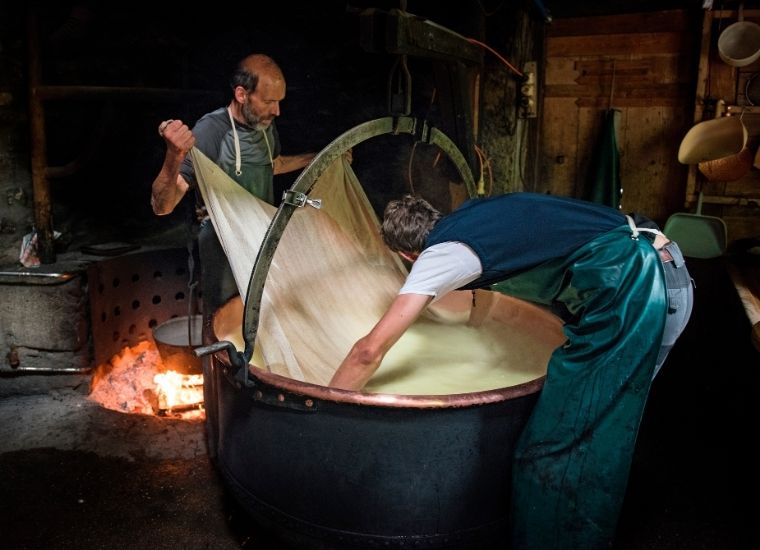
As you travel around the region, you will undoubtedly see cows grazing the rich meadows and pastures of the hillsides. They are the heroines of Switzerland’s high-quality cheese production. Alpine animal husbandry is one of the country’s biggest industries spawning a robust $60 million export economy. The prized Swiss cheeses are not necessarily from the Lake Geneva area, but they are served there.
Many melted cheese dishes like fondue, macaroni du chalet (macaroni cheese), and croute au fromage (open-face melted cheese sandwich) are popular with tourists and locals alike. Raclette, scraped from a gooey rectangular block onto a plate of potatoes, originated in neighbouring Canton Valais. Malakoffs are fried pillows of cheese allegedly developed by 19th century Swiss mercenary soldiers after returning home from battle at Fort Malakoff during the Crimean War. Vacherin Mont D’or is another cheese from the Romandie that is less seen on restaurant menus and more often served in Swiss homes. The soft whiffy wheels are made from unpasteurized milk from Montbéliarde cows eating fresh grass, then wrapped in a spruce bark hoop. The whole thing is baked in an oven into a bubbly golden delicious mess and served with bread or potatoes.
High-quality cheese is available in every Swiss grocery store and usually shrink-wrapped and easy to bring home. It’s the number one thing my visiting friends and family take back home with them because the quality and value is unbeatable here.
When seeking out cheese and food shops, don’t be afraid to move away from the lake where you’ll discover local boulangeries, patisseries, fromageries and charcuteries. Another golden rule in Switzerland: moving away from the waterfront promenades always takes you off the tourist track to more authentic spots.
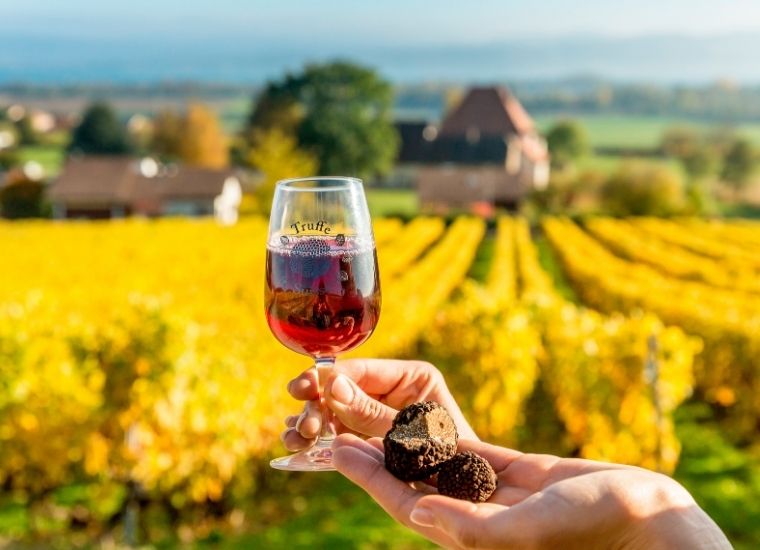
While cheese is my favourite Swiss food, Switzerland will forever be more associated with sweeter pleasures, fitting since it invented milk chocolate in the 19th century right here along the shores of Lake Geneva. Out of the many things that separate Switzerland’s two sides of the röstigraben, desserts and sweets are one of the most noticeably different. While French bakers were developing elaborately tiered cakes and pastry for its royal courts for centuries, much of protestant German-Speaking Switzerland was doing the opposite, banning cake and reforming its cuisine, culture and spirituality to be more efficient, more self sufficient and less wasteful.
Of course, there are good Swiss German desserts, but for the most part, they are sobering affairs, dry, often sweetened with fruit, and bereft of butter and cream, flavour, and flair. The Romandie is gloriously the opposite. Lausanne, for instance, has no shortage of chocolatiers and sweet shops. Pouly is a popular Lausanne patisserie beloved for its time-and labor-intensive viennoiserie and pastry like petite fours, canelés, religieuse, St Honore, eclairs, and madeleines, which you seldom see on the Swiss German side. Ditto for the multi-branch chain Fleur de Pains which creates mean croissants and petit fours on par with anything in Paris.
Excellent chocolate artisans, however, can be found everywhere in Switzerland. However, the ones in the Romandie tend to be more about artfulness instead of tradition. For 50 years, Lausanne’s La Chocolatière has been creating sublime chocolate eggs, silky truffles, fruity aiguillettes, paves, mendiants, and pralines. Durig creates artful organic fairtrade chocolate bark bars, studded jewel-like with colourful flowers, dried fruit, and pink peppercorns. Their delightfully designed moulds for Easter — the height of chocolate design in Switzerland — churn out a variety of bunnies, hens, and eggs. They also produce delightful designs for Christmas and Valentines. In a country divided by so many variables, it is reassuring to know that chocolate is the one thing that brings all Swiss together. Perhaps someday it could do the same for the world.
















 Back
Back